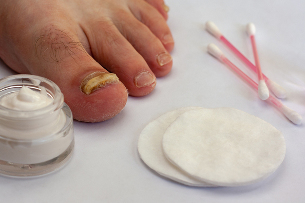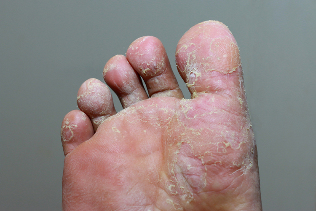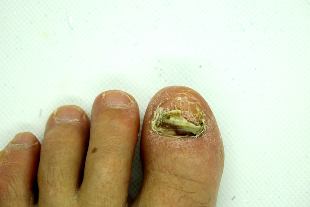Fungus on the toes – a problem troubling many. Itching, burning, and unsightly appearance of skin and nails – it is only a small part. The disease is dangerous the complications that cure even more difficult. However, to cope with the problem you can, if you really take to treat a fungal infection (mycosis).

Why there is mold on the foot?
Mushrooms – it is one of the types of infectious agents that attack the skin veils. It is heavy built and very tenacious microorganisms. So fungal diseases require a large and comprehensive approach to treatment.
Fungi have their favorite habitat on the skin. Firstly, it is the skin of the fingers on the feet and the nails. The reason for this is understandable – the soles of the feet are usually inside shoes, inside of which accumulates a lot of moisture and dirt, but also very hot. Therefore, the fungus that inhabit the legs, a lot of food and a favorable microclimate for breeding. Some of the kinds of complex mold more often attack the skin, while other kinds of fungi, e.g., yeast and mold, prefer the nail plate. It is also possible the simultaneous assault of several kinds of mold.
Contribute to the development of fungus on the toes of the feet:
- the reduction of local and general immunity;
- poor hygiene of the feet;
- uncomfortable and tight shoes;
- irregular change of socks or stockings;
- wear socks or stockings made of artificial, not that he throws away air materials;
- periodic hypothermia or overheating of the feet;
- violation of blood circulation in the legs;
- varicose veins;
- chronic diseases cardiovascular system, diabetes mellitus;
- a course of antibiotic therapy;
- excessive sweating of the feet;
- the lack of in the body vitamins and mineral elements;
- mechanical damage to the skin, bruising, injuries to the foot;
- being overweight, excessive physical load on the legs;
- irregular cut my nails on the feet.
The most important of these factors – reduced immunity and the violation of blood circulation in the legs. A decrease in immunity can occur due to various reasons. Usually it is hard to chronic diseases, mainly infectious. Also, immunity may be reduced due to HIV, receiving immunosuppressive drugs, oncological diseases. Of no less importance, and violation of blood circulation in the fingers on the leg – because of vascular disease, blood, diabetes mellitus, smoking.
Mycosis of the feet can develop in men and women. In adults appear more often than in children.
Some kinds of mold, constantly live on the skin and activates only when the adverse circumstances, for example, fungi of the genus Candida. While other species are transmitted from person to person. Infection can occur when you visit a gym, a spa, especially if the person has a personal footwear. Also a substantial risk of exposing people, friends someone else's shoes or socks, or give to other people to use. Often infection occurs during the use of the same towels, nail accessories, and so on Factors that the probability of infection – incisions on the surface of the skin, deformation of the nail plate.
The symptoms of mycosis of the toes
The main symptoms of athlete's foot – itching and burning. You can also observe the redness of the skin, small blisters, paved the peeling and roughness of the skin, unpleasant odor. The first signs of mycosis of the skin can be confused with just the tease.
Symptoms onichamykóza
The fungus can affect not only the skin but also the nails. The last variant of mycosis is called onychomycosis. The main symptom of onichamykóza – change the structure and type of the nail, its the increased capillary. Nails turn yellow, in its surface appear grooves and cracks, will the nail plate develop a yellowish thickened and deformed. If you do not deal with the treatment, the nail will gradually flake off from the nail bed and crumble.
What looks like fungus on her finger: photo
There is no need to establish the diagnosis alone, through photos. The diagnosis must be called by a qualified dermatologist.
Only he will be able to determine the type of mold. For that it may take not only the external inspection of the soles of the feet, but also laboratory analysis of skin scrapings.

However, the symptoms, at least remotely reminiscent of the shown on the photos – a reason for concern and appeal to the doctor.
Treatment of the disease is complex and is carried out in the home environment under the supervision of a physician.
Fungus on pinkie
The fungus can affect the skin of each finger of the feet. But little toes are most susceptible to infection. Pinky in tight shoes is often compressed, due to which the skin arise of scrapes and broken blood circulation. When damage to the nail of the little finger the disease develops very quickly, faster than on any other nail. During the assault the little finger of the infection very quickly can touch and the other fingers.
Sponge on the pinkie feet treats as well, such as the fungus to other areas of the skin. In onychomycosis of the nail of the little finger the most rational output can be his removal of the nail plate. It's a operation will not supply great discomfort for the patient, because the nails on the pinkie is growing rapidly. However, until the nails will not grow back again (it can take 3-4 months), it is necessary to use antifungal drugs for the prevention of re-infection.
Than to cure the nails on my toes?
Treatment of mycosis should be started when the first alarming symptoms. In the first place, it is necessary to turn to a dermatologist for a diagnosis. Before starting therapy it is necessary to install the very fact of the presence of mycosis and the type of pathogenic microorganisms. For this purpose, your doctor will take a scraping from the skin or reducing the piece of the nail (when damage to the nail). They hand out blood tests, blood sugar. Mycosis of the skin of the feet is to be distinguished from:
- other infectious diseases of the skin;
- allergic reactions;
- dermatosis caused by diabetes, vascular disease, stress and nervous diseases.
For the therapy of fungal infections on the feet are the most commonly used local agents (sprays, ointments, creams). Only in severe cases, your doctor may prescribe antifungal medications. The most commonly applied tablets with fluconazole in the Itraconazole terbinafina.
The treatment is based on the use of antimicrobial agents. This type of products contains substances, killing of the fungus (fungicidal) or stop their reproduction.
Also applies to local products with anti-bacterial, anti-inflammatory and keratolytic properties. Antibacterial means are in that case, if there is suppuration, it means that the fungal infection will connect to a bacterial. Anti-inflammatory drugs are okay to cope with unpleasant symptoms – itching and burning. However, they do not affect the very cause of the disease – pathogenic micro-organisms. To as keratolytic remedies include zinc, sulphuric acid is added and the sulfur-salicylic ointment. They accelerate the regeneration of skin tissues, thanks to accelerate the exfoliate deceased epidermis.
For the therapy of mycoses of feet also applies to trays with antiseptic agents – solutions of potassium permanganate, iodine, salt, baking soda, boric acid. Trays is best done before bedtime for a period of 20 minutes. To prevent infection of the disputes is the need to process the healthy areas of the skin chlorhexidine, iodine, hydrogen peroxide, potassium permanganate. For therapy onichamykóza to use lacquers with antifungal ingredients. These varnishes should be applied to the nail plate.
Ointments and creams you need to apply on pre-washed and clear skin with the frequency specified in the instructions to the car. The area of application of the ointment should be slightly larger areas of visible lesions. For use on natural nail plate of the nail Polish you need to steam, jagged edges will grind the nail file and the nail surface degrease alcoholic solution.
In folk medicine, how to get rid of mycosis on the feet are used decoctions of medicinal plants – chamomile, calendula, sage, st. john's wort, peppermint, solution of vinegar, onions and lemon juice.
What to do if there is a nail on her finger is not held?
Treatment of mycosis – is a long and difficult process. Fungal micro-organisms very resilient, and in a few days to get rid of them is impossible. Sometimes it takes many months of thorough therapy. This is not to discontinue the therapy even for a day. Treatment onichamykóza cannot be completed until it is grow back new, healthy will be the nail plate develop a yellowish.

It is important to take into account other factors associated with the development of the disorder. Non-compliance with hygiene of the skin and the optimum temperature regime of the feet can reduce to zero all the therapeutic efforts. This means that it is necessary to regularly wash the surface of the skin, stop, avoid overheating or hypothermia. It is also important to avoid mechanical damage to the skin, excessive load on the legs, cuts and injuries. Being overweight increases the pressure on the foot, therefore, if you are suffering from fullness, it is worth thinking about how to lose weight.
If the patient continues to wear the infected sponge shoes, it's not here give you any strong medication, because the place of the dead micro-organisms will be here to occupy the new. Therefore, it is necessary to get rid of all the factors that contribute to re-infection. You cannot walk in someone else's shoes, socks. Socks need to be carefully washed and changed regularly. The inner surface of the shoes is need to carefully spray the anti-fungal agents.
When resistant to fungus of the feet is necessary to analyze the overall health. Perhaps it will help reveal the causes of immunity disorders and blood circulation in the legs. So maybe it is worth to pass a comprehensive examination and to rule out problems with the heart, blood, blood vessels, organs of the endocrine system.
Finally, it is not excluded that the microorganisms only for insulin used antimicrobial methods. Then it will be necessary to change the product. May require systemic antimicrobial medicines in tablets. Dosage of drugs should choose an expert-a dermatologist.
























